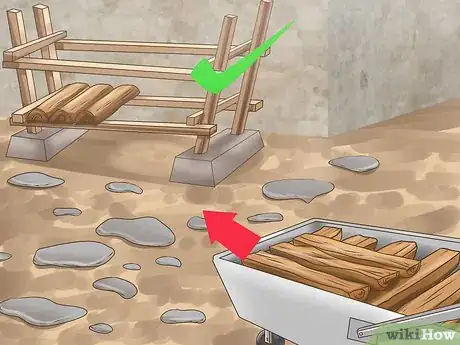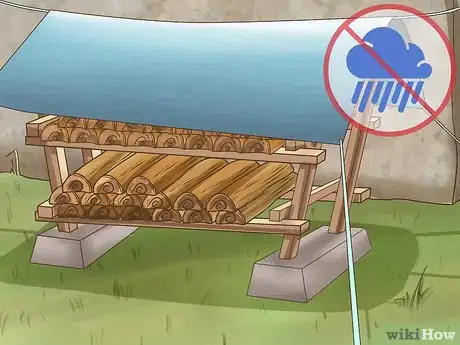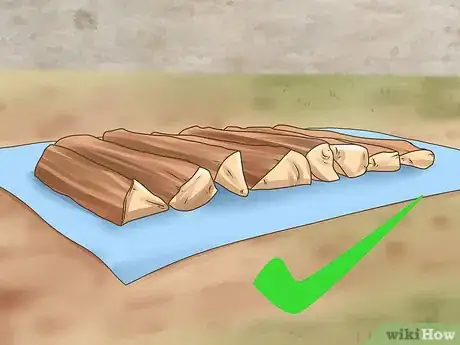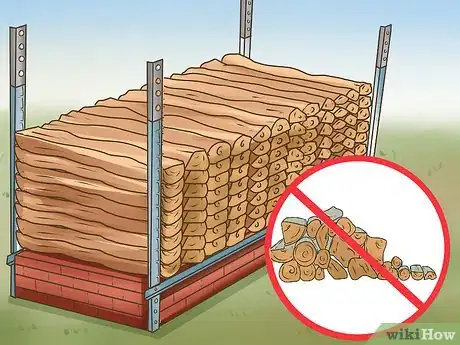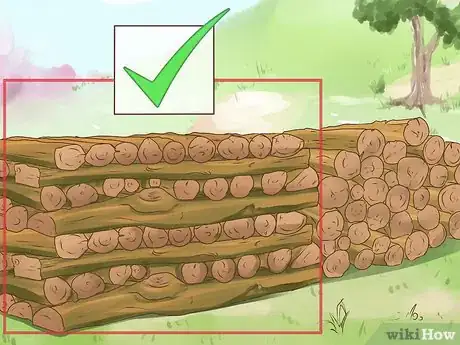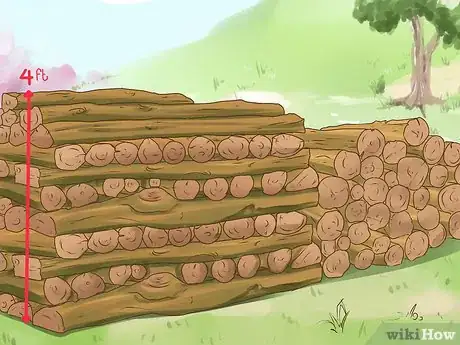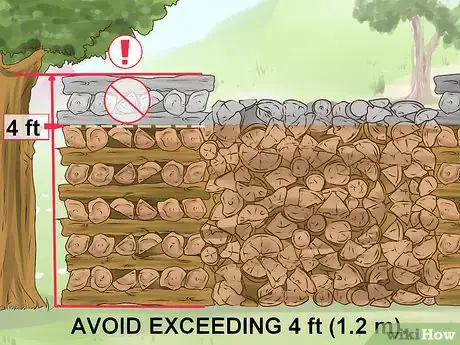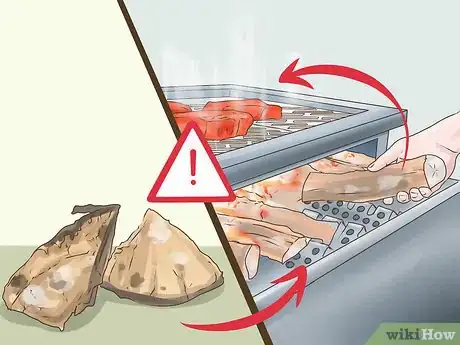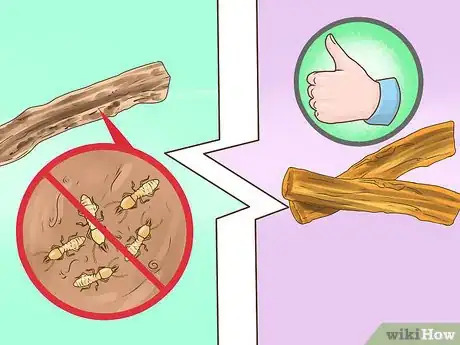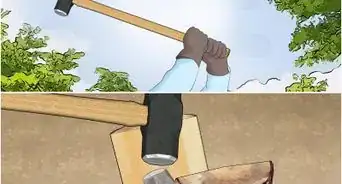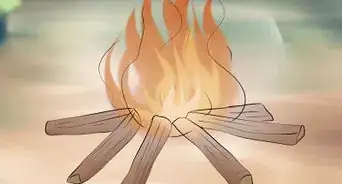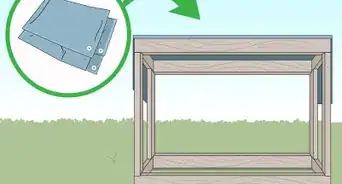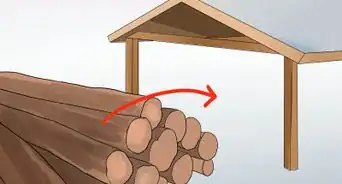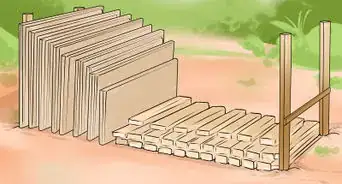This article was co-authored by wikiHow Staff. Our trained team of editors and researchers validate articles for accuracy and comprehensiveness. wikiHow's Content Management Team carefully monitors the work from our editorial staff to ensure that each article is backed by trusted research and meets our high quality standards.
This article has been viewed 29,753 times.
Learn more...
Firewood can be dirty, bug infested, or host fungus. Because of this, you may not want to store firewood in your home and instead want to store it outdoors. Stockpiling your firewood outdoors is relatively easy. It only requires a knowledge of the best conditions and locations for storage. When stockpiling your wood, you can make use of stacking techniques, like stacking wood between walls or posts. Once your firewood is safely stored, some knowledge of altered wood, particularly what's safe to burn and what's not, will ensure you have a safe, cozy fire in your future.
Steps
Selecting a Good Location
-
1Choose a location for dry wood storage. You'll likely want to store your wood close to where you're burning it for the sake of convenience. A storage shed, covered porch, the side of your house under the eaves, in a barn, or even a lean-to are all excellent spots.
- If the location you've chosen for your firewood is somewhat distant from where you'll be burning, you may want to use a wheelbarrow or wood carrier to help transporting it.
- Your wood doesn't have to be completely protected from the elements. Exposure to wind, sun, and even a little bit of rain seems to improve drying times.
-
2Prevent wood from getting wet again. Although a little bit of rain may help your wood dry faster, wood that is already dry can be protected with a tarp. Only cover the top ¼ of your wood with a tarp to maintain good airflow and prevent decay.Advertisement
-
3Keep firewood off the ground. Being in direct contact dirt will cause your firewood to decay more quickly than it would otherwise. Dirt is the natural environment of many kinds of wood eating bacteria, fungus, and bugs. To prevent decay, you might:
- Lay a tarp or a similar covering between wood and the dirt beneath it.
- Place 2x4 boards underneath your wood to separate it from the ground.[1]
- Layer clean gravel between your wood and the dirt.
-
4Check local regulations. Some communities or regions may have special regulations for firewood storage. You can easily find out this information by inquiring with your local fire department as to whether or not your storage location is in line with local code.[2]
Stacking Firewood
-
1Dry firewood completely. Properly dried firewood is easier to light, burns cleaner, and gives off more heat. There are two kinds of wet wood: green wood and seasoned wood that has gotten wet. Avoid covering both kinds with a tarp. The more air exposure wood has, the faster it will dry. Covering wood with a tarp may prolong the time it takes to dry and could cause mold to grow.
- "Green wood" means it has been freshly cut and still has green sap in it. This wood can take from several months to a year to dry. For the best and quickest results, cut the wood and store it where it will be protected from wetness.
- "Seasoned wood" means the green sap in the wood has already dried. If this kind of wood has gotten wet again, simply stack it in a place protected from moisture until it dries again.
-
2Check the dryness of your firewood. For green wood, you should wait a few months before testing the wood, but wood that's already seasoned may dry out in a few days to a week, depending on conditions. Check the dryness of your wood with a firewood moisture meter or by knocking together two pieces of wood. Dry wood knocked together will make a high pitched, cleaner sound; wet wood will produce a dull thud.
-
3Stack firewood between suitable walls or posts. Cement walls, metal T-posts, stacked cinder blocks, and similar stationary objects can be used to support the ends of your woodpile. This will prevent wood from rolling down the sides and becoming a tripping hazard.
- T-posts are relatively inexpensive and can easily be moved around, should you need to relocate your woodpile. Buy these at your local hardware store.[3]
-
4Create bookends with stacked wood. You can create a stable barrier on either end of your woodpile with an alternating crosswise pattern of stacked logs. Lay your first row of logs normally with front to back orientation with regard to the woodpile. Do this on a ground covering or 2x4 planks so the logs don't directly touch the ground. Then:
- At both ends, lay logs crosswise. These logs should occupy the entire front to back length of the logs on both ends. Generally, this pattern results in three logs oriented front to back, and three logs oriented left to right, though this number may vary.
-
5Continue to stack wood. The wood between your crosswise alternating stacks at both ends of the woodpile should be oriented front to back. As you add rows of front to back logs added between your bookends, add more rows of crosswise alternating logs at both ends.
- Do this until you are out of wood, or until your pile has become 4 ft (1.2 m) in height. At that point, start a new pile.[4]
-
6Avoid piling the wood too high. If you are using posts or crosswise stacked bookends to keep your firewood in place, avoid stacking the pile over 4 ft (1.2 m). This will cause the wood to become unstable, and could result in it falling and doing harm or damage.
- In some cases, like with a specially designed woodshed, you may be able to pile wood higher than 4 ft (1.2 m) safely. However, for freestanding woodpiles or those that are supported only at the ends, avoid exceeding 4 ft (1.2 m).[5]
Burning Firewood Safely
-
1Take precautions with moldy wood. Because mold can spread to your home, cause allergic reactions, aggravate respiration, and so on, moldy wood should always be stored outdoors. However, with cases of mild to moderate mold, you should be able to burn this without any issues.
- The negative health effects of wood mold are increased when smoke from burning moldy wood is inhaled.
- If you, a friend, or a family member is sensitive to mold, is allergic to it, or has asthma, you should avoid burning moldy firewood.
- A wood burning stove will limit inhalation, but cooking fires, campfires, or open hearth fires may cause aggravated respiration, asthma attacks, and so on.[6]
-
2Protect against insect infestation. While splitting wood, you may have noticed colonies of insects, either alive, dead, or dormant, inside the wood. This wood burns just fine, but it's best to burn it outdoors. Bringing infested wood in your home could cause the infestation to spread.
- You should also separate infested wood from non-infested wood. This way, the insects will not spread to the good wood.
-
3Avoid burning treated wood to prevent injury and harm. Many kinds of wood used in construction are treated with chemicals to prolong its life and integrity. When burned, this wood can release a deadly smoke that could cause permanent harm or death.
- While treated wood can be used in many different construction projects, the most common areas you'll find treated wood are: decks, railings, trim, and so on.
- Generally, treated wood has a greenish tinge to it. However, over time this color may have faded or otherwise changed. When in doubt, throw away potentially treated wood.
Warnings
- Avoid stacking firewood between trees or wooden posts. Although these can be handy "bookends" for your wood, over time damage can occur to the tree or post. Instead, use a simple T-post.[7]⧼thumbs_response⧽
References
- ↑ http://www.firewood-for-life.com/stacking-firewood-between-trees.html
- ↑ http://northwestforestproducts.com/firewood/firewood-storage/
- ↑ http://www.firewood-for-life.com/stacking-firewood-between-trees.html
- ↑ https://www.bobvila.com/articles/how-to-stack-firewood/
- ↑ http://www.firewood-for-life.com/stacking-firewood-between-trees.html
- ↑ http://www.firewood-for-life.com/firewood-mold.html
- ↑ http://www.firewood-for-life.com/stacking-firewood-between-trees.html
